
How Utah Brewers Four-to-Fived Our Beer
Beer & Spirits
Although stranger things are happening in 2020, we are excited to declare that our neighborhood beer has continued to prevail! In addition to numerous brwery launches, there is plenty planned for the coming months. But what happened during the huge change at last year’s end? In the beginning, something we all talked about was the switch from a limit of 4% to 5% ABV for beers available in grocery stores and on tap in Utah, and we’d wondered how it has impacted both the beer and the business. Here, some of the folks involved in the creations give us answers about how the change from 4% to 5% has benefitted the refreshing local beverages we all adore.
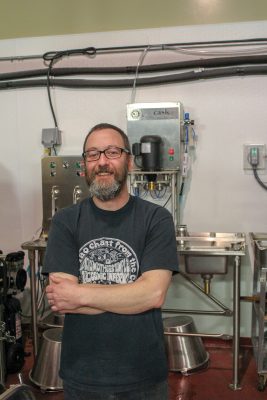
Desert Edge Brewery | Head Brewer Chad Krusell
desertedgebrewery.com
273 Trolley Square, SLC
801.521.8917
SLUG: Which Desert Edge beer do you feel benefited the most when moved from 4% to 5% and why?
Krusell: Pub Pils. It’s good for lower ABV. This one is like, no compromising at all—it’s just exactly what a pilsner should be. The higher ABV just grounds it out a little bit and makes it a little bit fuller. With light flavors and a little bitterness, the flavor of alcohol is unique.
SLUG: What challenges did Desert Edge experience making the switch
Krusell: Our Utah Pale Ale is a pretty popular beer, so I am already maxing out my volume with that—just adding a little bit more grain into a system that is already maxed-out is a little more labor-intensive as far as recipe formulation.
SLUG: Do you have a go-to session beer? Which and why?
Krusell: Some of my favorites are pilsners and lagers. I decided to brew a Vienna lager, and that would be my first chance to take it up to 5%. I think those soft, malty beers with that little extra ABV are just so good and still able to [be considered a] session beer.
SLUG: Is there anything exciting coming to Desert Edge Brewery?
Krusell: Now we’ve been open for a few weeks [amid COVID-19], we’re focusing on getting the tanks filled with our standard beers and fall-themed specials like our British Mild. As we do, we are planning to offer some of our 5% brews in six-packs to go, as well as trying to get the IPA and other higher-ABV stuff out there. Wheels are in motion! We’d also like to thank our customers for supporting us through this difficult time as they have for the last 25 years as a brewery and 49 years as a restaurant and pub. Cheers!
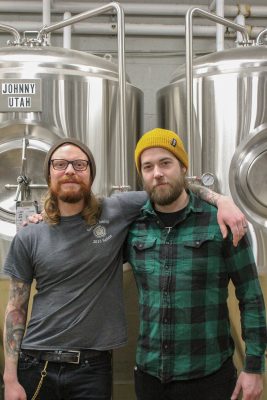
Proper Brewing Co. | (L–R) Head of Cellars Jeff Bunk, Head Brewer Jack Kern
properbrewingco.com
857 S. Main St., SLC
801.953.1707
SLUG: Which Proper beer do you feel benefited the most when moved from 4% to 5% ABV?
Both: Proper Beer!
Kern: We were already talking about making changes to the flavor profile, and with the ABV bump, we looked at it as an opportunity. We lowered the bittering so when the alcohol scaled, that meant more malt. We just kept the hops exactly how they were, and the first batch was perfect.
SLUG: What challenges did Proper Brewing Co. experience making the switch?
Bunk: Beckerman’s Brew was a little bit difficult. Hopspital IPA has a few little things here and there—but we were also already experimenting with changing the base malt for that, so it was already going through a change. I remember specifically trying to get the bittering to where it was.
Kern: Hopspital was heavy on certain things, so we’ve worked with that. But Beckerman’s was more about balancing the hops again, with a light beer.
SLUG: Do you have a go-to session beer? Which and why?
Kern: Proper Beer or our other golden ale, Winchester. In general, I am partial to Vienna lager—Victoria Mexican Lager, specifically. That’s my favorite session beer.
Bunk: If I am drinking here, it’s Proper and Winchester. Full Suspension [Squatters], that’s a pretty good damn beer. And it just stays old-school.
SLUG: Is there anything exciting coming to Proper Brewing Co.?
Kern: We are working on releasing our Honey Vienna Lager, Stumblebee, in cans as well. The ones to keep a look out for are the barrel-aged beers that [Head of Cellars] Jeff Bunk is nurturing. We have several variations in whiskey and wine casks now. Some are ready for a fall release. Others further down the road. He has rum and reposado casks to play with in the future as well.
Editor’s note: In the final quote of this Proper Brewing Q&A vignette, the person nurturing barrel-aged beers was erroneously misquoted as being “[Executive Chef] Jeff Springer” and has been corrected to “[Head of Cellars] Jeff Bunk.”
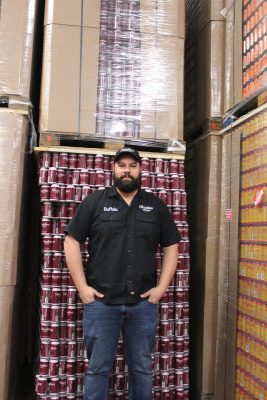
Shades Brewing | Head Brewer Márcio Buffolo
shadesbrewing.beer
154 W. Utopia Ave., South Salt Lake
435.200.3009
SLUG: Which Shades beer do you feel benefited the most when moved from 4% to 5% ABV and why?
Buffolo: Hazy IPA Grapefruit Revolution. You could taste it was watered down, and the bitterness was too strong when it was 4%. It was balanced and “grapefruity,” but moving it up, we could try to reach more on the “hazy pale” side or Northeast style. We dropped the bitterness, increased the dry hop at the end, increased sweetness and ABV, and gave more whirlpool hops, increasing the hop flavor. The 5% gained body and hop profile, and notes of passionfruit came through that were not present [at] 4%.
SLUG: What challenges did Shades Brewing experience making the switch?
Buffolo: We used the opportunity to switch packaging from bottles to cans. On the beer side, it was trying not to shoot higher than 5%. We tried to keep the recipe as close to the 4% that we could but improve some. Customers get used to what they taste, and if you mess with the taste, they could complain that it isn’t the beer they used to drink.
SLUG: Do you have a go-to session beer? Which and why?
Buffolo: Plum Berliner Weisse [from Shades Brewing]. It’s tropical, fruity, not overly sour and is balanced and easy-drinking. With the lower ABV, it’s a beer within its true style.
SLUG: Is there anything exciting coming to Shades Brewing?
Buffolo: A sister-company, Fit Brewing, is what we are trying to push. We believe in the low-calorie, low-ABV beer with flavor, not just a watered-down beer.
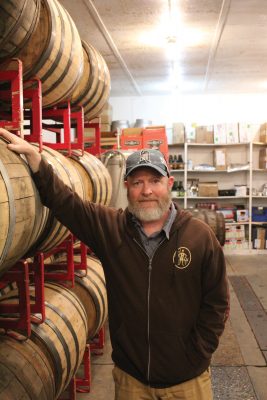
Red Rock Brewing Co. | Head Brewer Kevin Davis
redrockbrewing.com
443 N. 400 West, SLC
801.214.3386
SLUG: Which Red Rock beer do you feel benefited the most when moved from 4% to 5% ABV and why?
Davis: Grand Bavaria. That beer was in the State Liquor Store, and we’ve moved it to the grocery stores and on draft. It was already 5%, so we didn’t have to change anything. Having it on the grocery shelf cold is so much nicer than picking up a warm bottle. It’s been flying since we did that.
SLUG: What challenges did Red Rock experience making the switch
Davis: Just changing the recipes and getting the alcohol content right. Brewing beer is a natural process; you work with natural, raw materials, and there’s natural variation with those. Getting 5% on the nose is a little tricky without having a measurement tool to do that. We’ve been fortunate. Uinta has been generous by allowing us to measure our beers over there; so, kudos to them and thank you.
SLUG: Do you have a go-to session beer? Which and why?
Davis: [Red Rock Brewing Co.’s] Black Lager. I’ve been really digging dark beers, so the Black Lager that we have in grocery and on draft has really been hitting the spot for me. It’s a big, malty lager, but still hits that drinkable, quality German black lager that you would expect.
SLUG: Is there anything exciting coming to Red Rock Brewing Co.?
Davis: We are working on a Pumpkin Chocolate Chip Milk Stout, exclusive to Harmons Grocery. Currently, we are test-brewing some imperial stouts with fun flavors like tiramisu slated for later this year. Griswald’s and White Rainbow are also already brewing.
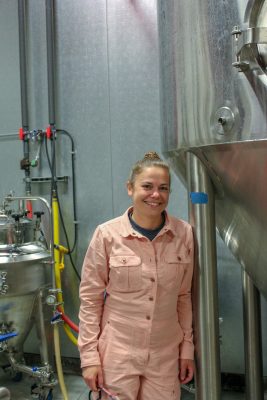
Uinta Brewing Co. | Brewing Supervisor Lauren Lerch
uintabrewing.com
1722 S. Fremont Dr., SLC
801.467.0909
SLUG: Which Uinta beer do you feel benefited the most when moved from 4% to 5% ABV and why?
Lerch: Trader IPA! While increasing grain amounts to make our 4%-ABV beers 5% ABV, we took the opportunity to slightly tweak a few recipes. Trader not only received changes to the grain amounts, but also the types of grain and hops used. The consumer definition of an IPA has drifted and split into a ridiculous amount of subcategories over the past 30 years. We didn’t want Trader to get stuck in the past. The ABV increase and new overall impression has steered it closer to what consumers might expect from an IPA in 2020. The new Trader has a more approachable bitterness with soft pine and citrus notes. If you haven’t cracked a can in a while, now is the time to revisit.
SLUG: What challenges did Uinta Brewing experience making the switch?
Lerch: Our challenges were much the same as most other brewers in Utah. Recipes that had been dialed in for years were suddenly needing extra attention and further tweaking to make sure we were hitting all of our targets from a data-and-sensory standpoint. It wasn’t as simple as adding a few extra bags of grain and calling it good. It took a few months for each brand to settle into its own and for the brewers to have consistent results from each brew. It was like taking the majority of our brands back into infancy in order to re-raise them as more relevant, higher-percent-ABV versions of themselves. We’re proud parents.
SLUG: Do you have a go-to session beer? Which and why?
Lerch: Of Uinta’s brands, 801 Pilsner is my go-to. Lagerbier has my heart, and 801 fills it like a frothy, German-style pour. Red Rock Zwickelbier and T.F. Kellerbier are equal loves. You’ll never change my mind.
SLUG: Is there anything exciting coming to Uinta Brewing?
Lerch: So much! [Replying mid-September,] the Uinta pub is reopening within a month. Our food offerings are getting a massive upgrade, and we’re excited to get a lot more creative/experimental brews flowing from our taps. We’ve beefed up our R&D capacity, which means more cool stuff for you to drink. Our small-batch, limited-release series will continue to roll out new packaged suds. Ataraxy New England–Style IPA was our first release of the series with Turn Farm Cream Ale on its heels. And let’s not forget about the return of Sea Legs Baltic Porter!
